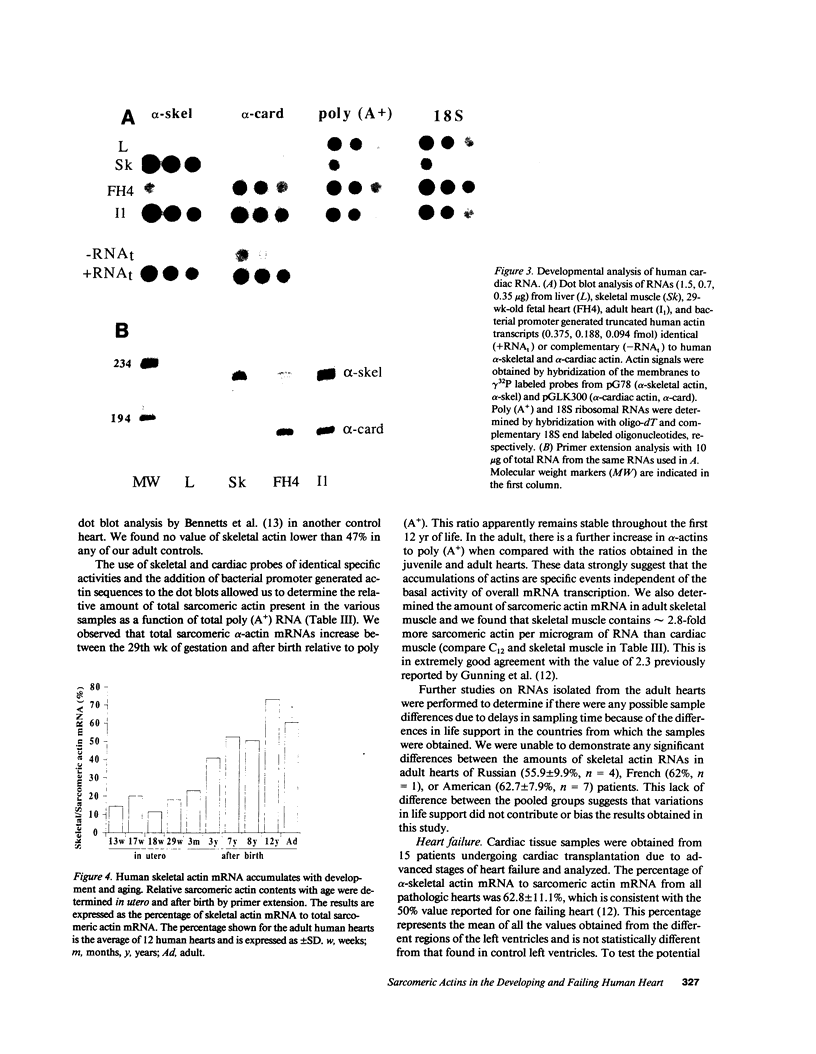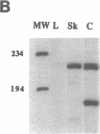Abstract
Expression of the two sarcomeric actins, alpha-skeletal and alpha-cardiac, is regulated in the rodent heart in response to developmental, hormonal, and hemodynamic stimuli. Little is known in man, except that both isogenes were found to be coexpressed in three adult ventricles. In this report, we investigated the isoactin mRNA composition in ventricles from 21 control patients (4 fetal, 5 juvenile, 12 adult) and from 15 patients undergoing cardiac transplantation (5 idiopathic dilated cardiomyopathies, 5 ischemic myopathies with myocardial infarcts, 5 diverse etiologies) by two different and complementary techniques: RNA dot blot analysis with specific cDNA probes, and primer extensions with an oligonucleotide common to alpha-cardiac and alpha-skeletal actins. In the case of dot blot analysis, quantification of each isoform was performed by using as standards RNA transcripts obtained from cloned human alpha-actin sequences, and the total amount of sarcomeric actin mRNA was evaluated as a function of total poly(A+)RNA. We found that both isogenes are always coexpressed, and that the isoactin pattern changes during development. In utero and in neonatal hearts, alpha-skeletal actin mRNA represents less than or equal to 20% of sarcomeric actins, it increases to 48 +/- 6% during the first decade after birth and becomes the predominant isoform of adult hearts (60.4 +/- 8.5%). The 15 adult failing hearts exhibited the same isoactin pattern as the control ones (62.84 +/- 11.06%), and there was no difference in expression between patients with dilated cardiomyopathy or ischemic heart disease. These observations demonstrate that cardiac development in man, in contrast to rodent heart, is characterized by an up-regulation of the skeletal actin gene, the expression of which does not change in hypertrophied and failing hearts, and suggest that the actin and myosin heavy chain families are independently regulated in human heart.
Full text
PDF







Images in this article
Selected References
These references are in PubMed. This may not be the complete list of references from this article.
- Bennetts B. H., Burnett L., dos Remedios C. G. Differential co-expression of alpha-actin genes within the human heart. J Mol Cell Cardiol. 1986 Sep;18(9):993–996. doi: 10.1016/s0022-2828(86)80013-x. [DOI] [PubMed] [Google Scholar]
- Bishopric N. H., Simpson P. C., Ordahl C. P. Induction of the skeletal alpha-actin gene in alpha 1-adrenoceptor-mediated hypertrophy of rat cardiac myocytes. J Clin Invest. 1987 Oct;80(4):1194–1199. doi: 10.1172/JCI113179. [DOI] [PMC free article] [PubMed] [Google Scholar]
- Bouvagnet P., Neveu S., Montoya M., Leger J. J. Development changes in the human cardiac isomyosin distribution: an immunohistochemical study using monoclonal antibodies. Circ Res. 1987 Sep;61(3):329–336. doi: 10.1161/01.res.61.3.329. [DOI] [PubMed] [Google Scholar]
- Chirgwin J. M., Przybyla A. E., MacDonald R. J., Rutter W. J. Isolation of biologically active ribonucleic acid from sources enriched in ribonuclease. Biochemistry. 1979 Nov 27;18(24):5294–5299. doi: 10.1021/bi00591a005. [DOI] [PubMed] [Google Scholar]
- Cox R. D., Garner I., Buckingham M. E. Transcriptional regulation of actin and myosin genes during differentiation of a mouse muscle cell line. Differentiation. 1990 Jun;43(3):183–191. doi: 10.1111/j.1432-0436.1990.tb00445.x. [DOI] [PubMed] [Google Scholar]
- Gunning P., Mohun T., Ng S. Y., Ponte P., Kedes L. Evolution of the human sarcomeric-actin genes: evidence for units of selection within the 3' untranslated regions of the mRNAs. J Mol Evol. 1984;20(3-4):202–214. doi: 10.1007/BF02104727. [DOI] [PubMed] [Google Scholar]
- Gunning P., Ponte P., Blau H., Kedes L. alpha-skeletal and alpha-cardiac actin genes are coexpressed in adult human skeletal muscle and heart. Mol Cell Biol. 1983 Nov;3(11):1985–1995. doi: 10.1128/mcb.3.11.1985. [DOI] [PMC free article] [PubMed] [Google Scholar]
- Gustafson T. A., Kedes L. Identification of multiple proteins that interact with functional regions of the human cardiac alpha-actin promoter. Mol Cell Biol. 1989 Aug;9(8):3269–3283. doi: 10.1128/mcb.9.8.3269. [DOI] [PMC free article] [PubMed] [Google Scholar]
- Hamada H., Petrino M. G., Kakunaga T. Molecular structure and evolutionary origin of human cardiac muscle actin gene. Proc Natl Acad Sci U S A. 1982 Oct;79(19):5901–5905. doi: 10.1073/pnas.79.19.5901. [DOI] [PMC free article] [PubMed] [Google Scholar]
- Izumo S., Nadal-Ginard B., Mahdavi V. Protooncogene induction and reprogramming of cardiac gene expression produced by pressure overload. Proc Natl Acad Sci U S A. 1988 Jan;85(2):339–343. doi: 10.1073/pnas.85.2.339. [DOI] [PMC free article] [PubMed] [Google Scholar]
- Lompré A. M., Mercadier J. J., Schwartz K. Changes in gene expression during cardiac growth. Int Rev Cytol. 1991;124:137–186. doi: 10.1016/s0074-7696(08)61526-0. [DOI] [PubMed] [Google Scholar]
- Mayer Y., Czosnek H., Zeelon P. E., Yaffe D., Nudel U. Expression of the genes coding for the skeletal muscle and cardiac actions in the heart. Nucleic Acids Res. 1984 Jan 25;12(2):1087–1100. doi: 10.1093/nar/12.2.1087. [DOI] [PMC free article] [PubMed] [Google Scholar]
- Mendez R. E., Pfeffer J. M., Ortola F. V., Bloch K. D., Anderson S., Seidman J. G., Brenner B. M. Atrial natriuretic peptide transcription, storage, and release in rats with myocardial infarction. Am J Physiol. 1987 Dec;253(6 Pt 2):H1449–H1455. doi: 10.1152/ajpheart.1987.253.6.H1449. [DOI] [PubMed] [Google Scholar]
- Mercadier J. J., Bouveret P., Gorza L., Schiaffino S., Clark W. A., Zak R., Swynghedauw B., Schwartz K. Myosin isoenzymes in normal and hypertrophied human ventricular myocardium. Circ Res. 1983 Jul;53(1):52–62. doi: 10.1161/01.res.53.1.52. [DOI] [PubMed] [Google Scholar]
- Mercadier J. J., Lompré A. M., Duc P., Boheler K. R., Fraysse J. B., Wisnewsky C., Allen P. D., Komajda M., Schwartz K. Altered sarcoplasmic reticulum Ca2(+)-ATPase gene expression in the human ventricle during end-stage heart failure. J Clin Invest. 1990 Jan;85(1):305–309. doi: 10.1172/JCI114429. [DOI] [PMC free article] [PubMed] [Google Scholar]
- Minty A. J., Alonso S., Caravatti M., Buckingham M. E. A fetal skeletal muscle actin mRNA in the mouse and its identity with cardiac actin mRNA. Cell. 1982 Aug;30(1):185–192. doi: 10.1016/0092-8674(82)90024-1. [DOI] [PubMed] [Google Scholar]
- Miwa T., Kamada S. The nucleotide sequence of a human smooth muscle (enteric type) gamma-actin cDNA. Nucleic Acids Res. 1990 Jul 25;18(14):4263–4263. doi: 10.1093/nar/18.14.4263. [DOI] [PMC free article] [PubMed] [Google Scholar]
- Nadal-Ginard B., Mahdavi V. Molecular basis of cardiac performance. Plasticity of the myocardium generated through protein isoform switches. J Clin Invest. 1989 Dec;84(6):1693–1700. doi: 10.1172/JCI114351. [DOI] [PMC free article] [PubMed] [Google Scholar]
- Ordahl C. P. The skeletal and cardiac alpha-actin genes are coexpressed in early embryonic striated muscle. Dev Biol. 1986 Oct;117(2):488–492. doi: 10.1016/0012-1606(86)90315-5. [DOI] [PubMed] [Google Scholar]
- Parker T. G., Packer S. E., Schneider M. D. Peptide growth factors can provoke "fetal" contractile protein gene expression in rat cardiac myocytes. J Clin Invest. 1990 Feb;85(2):507–514. doi: 10.1172/JCI114466. [DOI] [PMC free article] [PubMed] [Google Scholar]
- Reddy S., Ozgur K., Lu M., Chang W., Mohan S. R., Kumar C. C., Ruley H. E. Structure of the human smooth muscle alpha-actin gene. Analysis of a cDNA and 5' upstream region. J Biol Chem. 1990 Jan 25;265(3):1683–1687. [PubMed] [Google Scholar]
- Sassoon D. A., Garner I., Buckingham M. Transcripts of alpha-cardiac and alpha-skeletal actins are early markers for myogenesis in the mouse embryo. Development. 1988 Sep;104(1):155–164. doi: 10.1242/dev.104.1.155. [DOI] [PubMed] [Google Scholar]
- Schiaffino S., Samuel J. L., Sassoon D., Lompré A. M., Garner I., Marotte F., Buckingham M., Rappaport L., Schwartz K. Nonsynchronous accumulation of alpha-skeletal actin and beta-myosin heavy chain mRNAs during early stages of pressure-overload--induced cardiac hypertrophy demonstrated by in situ hybridization. Circ Res. 1989 May;64(5):937–948. doi: 10.1161/01.res.64.5.937. [DOI] [PubMed] [Google Scholar]
- Schwartz K., de la Bastie D., Bouveret P., Oliviéro P., Alonso S., Buckingham M. Alpha-skeletal muscle actin mRNA's accumulate in hypertrophied adult rat hearts. Circ Res. 1986 Nov;59(5):551–555. doi: 10.1161/01.res.59.5.551. [DOI] [PubMed] [Google Scholar]
- Taylor A., Erba H. P., Muscat G. E., Kedes L. Nucleotide sequence and expression of the human skeletal alpha-actin gene: evolution of functional regulatory domains. Genomics. 1988 Nov;3(4):323–336. doi: 10.1016/0888-7543(88)90123-1. [DOI] [PubMed] [Google Scholar]
- Ueyama H., Hamada H., Battula N., Kakunaga T. Structure of a human smooth muscle actin gene (aortic type) with a unique intron site. Mol Cell Biol. 1984 Jun;4(6):1073–1078. doi: 10.1128/mcb.4.6.1073. [DOI] [PMC free article] [PubMed] [Google Scholar]
- Vandekerckhove J., Bugaisky G., Buckingham M. Simultaneous expression of skeletal muscle and heart actin proteins in various striated muscle tissues and cells. A quantitative determination of the two actin isoforms. J Biol Chem. 1986 Feb 5;261(4):1838–1843. [PubMed] [Google Scholar]
- Winegrad S., Wisnewsky C., Schwartz K. Effect of thyroid hormone on the accumulation of mRNA for skeletal and cardiac alpha-actin in hearts from normal and hypophysectomized rats. Proc Natl Acad Sci U S A. 1990 Apr;87(7):2456–2460. doi: 10.1073/pnas.87.7.2456. [DOI] [PMC free article] [PubMed] [Google Scholar]






